
views
X
Research source
Interestingly, even some native speakers of these languages have trouble with rolling Rs, and some people are never able to roll their Rs. If you are a native English speaker you may never have had to roll your Rs before (the English language doesn’t require this sound) and learning to do so can be quite difficult.
Learning Proper Tongue Placement
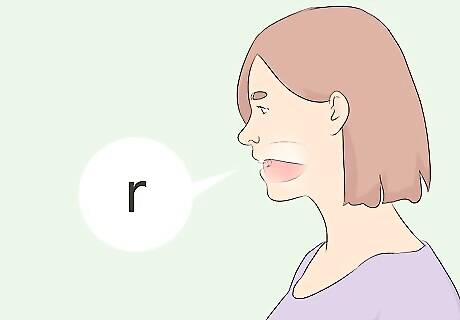
Make the proper movements with your mouth. The English R sound is made by the movement made between your bottom lip and your top teeth. Alternative, the rolling R sound is made by vibrating your tongue against the back of your top teeth, which is very similar to the way your mouth moves when you say an English T or D. Start by saying the letter R, in English, out loud. Pay attention to how your mouth moves while you say the letter R. You’ll notice that your tongue does not touch the back of your teeth, it sort of just hangs there in mid-air. Now say the letters T and D, in English, out loud. Pay attention to how your mouth moves when you say T and D. You’ll notice that your tongue touches the back of your upper front teeth — almost like your tongue is pushing your teeth forward. The placement of your tongue while you say T and D in English is the same placement you need to perfect when attempting to roll your Rs. But in addition to your tongue simply touching the back of your front teeth, it also has to vibrate. It’s this vibration that creates the trill or rolling sound. The important part of this step is to recognize how your mouth and tongue should move in order to roll your Rs. When you move forward and start practicing the actual rolling R sound, remember to pay attention to your tongue placement.
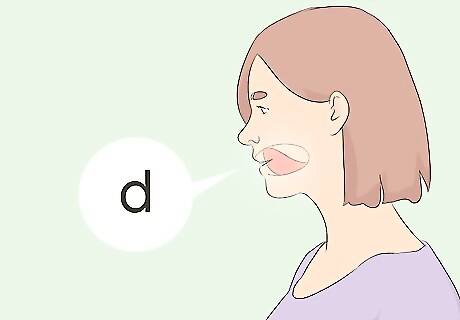
Transition from the D or T sound. Start this step by placing your mouth and tongue in the practiced location when saying the letters D or T in English. This position will have your tongue resting very lightly against the back of your front teeth. Once your mouth is in this position, breathe out through your mouth only. Keep your tongue relaxed while you do this so it vibrates against your front teeth. Tip: The key to this step is to practice getting your tongue to vibrate. By keeping your tongue relaxed in your mouth and breathing out, the flow of air from your lungs should force your tongue to vibrate. If it isn’t vibrating it might be that you aren’t keeping your tongue relaxed enough. This step, like all others, requires practice. To help you gain success with this step, you might want to try actually saying the sounds associated with the letters T and D in English. As you’re saying either the T or D sounds, add some Rs to the end of the sound so you’re making the sounds “drrr” and “trrr.” Breathe out while doing this and practice getting your tongue to vibrate. You can also try saying English words that start with D, T, B, or P and have an R as the second letter in the word (e.g. Dracula, train, bronze, pretty). By practicing words that include D, T, B, P and an R you’re essentially practicing a rolling R because your tongue is in the correct position. The key is to get your tongue to vibrate when saying the R so it rolls.
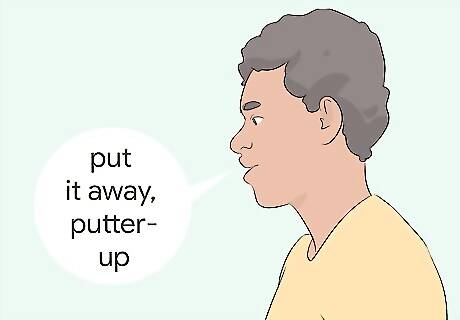
Say English phrases that put your tongue in the right position. In addition to the “drrr” and “trrr” sounds there are English phrases that can help put your tongue in the right position for rolling an R. Use either the phrase ”put it away” or ”putter-up” and you’ll notice your tongue pushes against the back of your front teeth. This is the same position you want your tongue in when rolling your Rs.

Use the butter/ladder method. The words “butter” and “ladder” in English are similar to using a word that starts with D, T, B, or P and has an R as the second letter. These two words also place your tongue against the back of your front teeth, which is the same placement you need to roll your Rs. In the case of these two words, your tongue goes to the back of your front teeth when you say the second syllable of the word — when you say the sounds produced by “tter” and “dder." You can say one of the words, or both of them. For example, you can say “butter butter butter ladder ladder ladder” over and over again, or any combination of the two words. Keep repeating the words faster and faster. The faster you say the words, the higher the chance that your tongue will vibrate. Eventually the “tter” and “dder” parts of the words should take on the trilling sound of a rolling R.
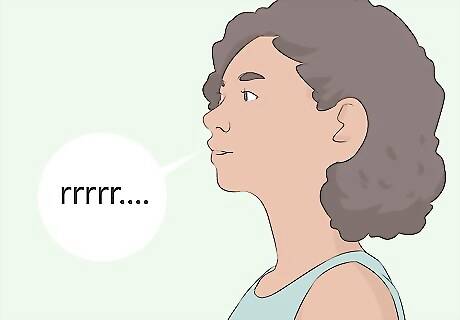
Practice rolling a single R. At this point you should know where your tongue should be inside your mouth when you roll an R. You’ve also practiced this movement by saying other English words that produce the same movement. In the process you’ve hopefully got your tongue to vibrate against the back of your teeth. Now take all you’ve learned and practice saying only a rolling R. It may take weeks before you’re able to move to this step and successfully roll an R. Be patient, it’s not easy. The key to this step is to be able to produce a successful rolled R without the need to add extra letters or words. Once you’re able to successfully roll one R, keep practicing over and over. It should eventually become second nature such that you aren’t even thinking about what your mouth is doing when you roll an R.
Using Tongue Twisters for Practice

Loosen up your tongue. The rolling R sound requires that your tongue be quite relaxed so it can vibrate freely when you talk. Because a relaxed tongue is not usually required to speak English, you may need to practice relaxing your tongue before you can successfully roll your Rs. Use the phrase ”tee dee va” to loosen your tongue. Say this phrase over and over again as quickly as you can. Remember to keep your tongue relaxed and loose inside your mouth. Your tongue is a muscle, so you may need to practice quite a bit before you can naturally relax it enough to roll an R.

Practice your rolling R sounds with a phrase in Spanish. Many people, including children, are taught this rhyme in order to help learn the proper pronunciation of the letter R in Spanish, which produces the same sound as a rolling R. You can use this rhyme to practice your rolling Rs, no matter what language you’re going to use the rolling R for. The tongue twister is ”El perro de san Roque no tiene rabo, porque Ramón Ramirez se lo ha robado.” The English translation of this tongue twister is “The dog of san Roque has no tail, because Ramón Ramirez stole it." There are only certain times when the rolled (or trilled) R is used in Spanish: when it is the first letter of a word (e.g. Roque or rabo); or when there is a double R in the middle of a word (e.g. perro). When saying the rhyme, these are the only times you should be rolling the R. When the letter R appears in a Spanish word by itself in the middle of the word, it shouldn’t be rolled. Instead the sound produced should sound similar to the sound “dd” would make in English. If you need help pronouncing the single R properly, try listening to this video as an example — http://www.studyspanish.com/pronunciation/letter_r.htm. If it helps, start by practicing only the words that produce the rolling R sound. Once you’re able to say the individual words properly, move onto saying the entire rhyme. Repeat the rhyme over and over again, getting faster and faster each time. The key is to be able to say all the words, including the rolling R sound, without proactively thinking about the fact that you’re rolling your Rs.
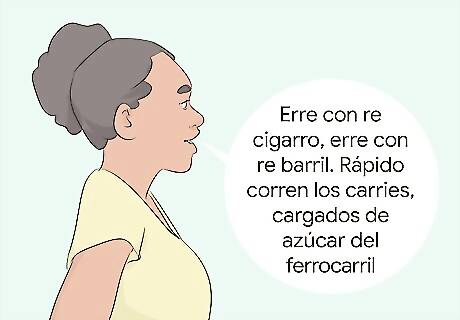
Try a tongue twister in Spanish. The following Spanish tongue twister can be used to practice your rolling R sound, regardless of what language you’re learning: "Erre con re cigarro, erre con re barril. Rápido corren los carries, cargados de azúcar del ferrocarril.” Start by saying the tongue twister slowly. Once you’ve got the knack of saying the tongue twister, start saying it over and over again at a faster rate. In English this tongue twister translates to “R with R cigar, R with R barrel, swift roll the wagons, carrying sugar of the train." Alternate version 1 — "Erre con erre cigarro, erre con erre barril. Rápido corren los carros, detrás del ferrocarril.” Alternate version 2 — "Erre con erre guitarra, erre con erre barril. Mira que rápido ruedan, las ruedas del ferrocarril.” There are only certain times when the rolled (or trilled) R is used in Spanish: when it is the first letter of a word (e.g. Roque or rabo); or when there is a double R in the middle of a word (e.g. perro). When saying the tongue twister, these are the only times you should be rolling the R. Remember that when the letter R appears in a Spanish word by itself in the middle of the word, it shouldn’t be rolled. Instead the sound produced should sound similar to the sound “dd” would make in English. If you need help pronouncing the single R properly, try listening to this video as an example — http://www.studyspanish.com/pronunciation/letter_r.htm. As you get faster and faster with the tongue twister, the rolling R sound should come naturally.

Alternate tongue twisters. To keep yourself from getting bored, and to ensure you can roll your Rs when saying more than one word or sentence, try a different tongue twister every now and again. This tongue twister is about three sad tigers: "Tres tristes tigres tragaban trigo en un trigal en tres tristes trastos. En tres tristes trastos tragaban trigo tres tristes tigres.” Alternate version 1 — "Tres tristes tigres triscaban trigo en un trigal. Un tigre, dos tigres, tres tigres trigaban en un trigal. ¿Qué tigre trigaba más? Todos trigaban igual.” Alternate version 2 — "En tres tristes trastos de trigo, tres tristes tigres comen trigo. Comen trigo, tres tristes tigres, en tres tristes trastos de trigo.” Again, you only need to produce a rolling R sound when the first letter of a word is an R (e.g. Roque or rabo) or when there is a double R in the middle of a word (e.g. perro). If the letter R appears in a Spanish word by itself in the middle of the word, it shouldn’t be rolled. Instead it should sound something like “dd” would make in English. If you need help pronouncing the single R properly, try listening to this video as an example — http://www.studyspanish.com/pronunciation/letter_r.htm. As you get faster and faster with the tongue twister, the rolling R sound should come naturally.
Borrowing English Words and Sounds to Learn a Rolling R

Try the Tiger Method. The Tiger Method helps to teach you the trick of vibrating your tongue, which is needed in order to roll your Rs. This method evolves as follows: Clear your throat. This should sound something like “ckh.” While clearing your throat, turn the “ckh” sound into a “grrr” sound. The key to these sounds is making the roof of your mouth vibrate. Say the letter L or N and pay attention to the place where your tongue ends up at the end of the letter. This spot is your alveolar ridge. Put your tongue on your alveolar ridge and say the words “girl” and “hurl” without removing your tongue from the ridge. Use the ‘clear your throat’ routine to start the word and turn the vibration into a rolled R.

Use the Raspberry Method. This method using the sound that results from blowing a raspberry to help learn how to roll your Rs. The steps are as follows: Start by blowing a regular raspberry. Add your voice to the sound of the raspberry. This can be done by simply using your vocal cords to make noise. As you’re blowing a raspberry with vocal sound, lower your jaw as part as possible without stopping the raspberry. Once your jaw is in a lower position, move your tongue to the alveolar ridge without changing anything else you’re doing. At this point your should be rolling an R. If not, try the method again until you can end with a rolling R.
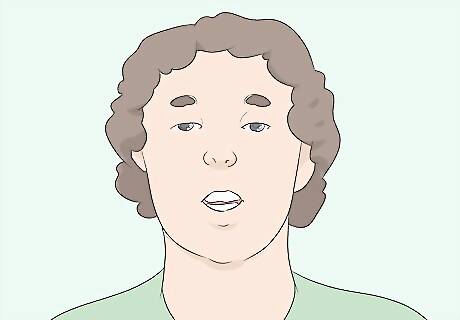
Consider the Vision Dream Method. This method involves speaking quite loudly, so you’ll want to try this somewhere you won’t be bothering anyone. Follow these steps: Take a deep breath. Say the word “vision.” Make the middle of the word (which sounds like “zh”) last 3-4 seconds. As you extend the “zh” sound over those 3-4 seconds, increase the volume of the sound. The last part of the word (the ’n’) should be very short, but should also continue to increase in volume. At this point you should be quite loud. Add the word “dream” to create a phrase. There should be less than a second between finishing the word “vision” and starting the word “dream.” The “dr” part of the word “dream” should be the climax of the phrase. When you get to the “dr” part of the word “dream,” relax your tongue and make it go floppy. Since you’re speaking very loudly now, the breath coming out of your mouth should make your tongue vibrate. Let this happen (and keep your tongue relaxed). If successful, it should sound like you’re saying something like “dagadaga." You may need to try this several times before you get to the point where you’re making a good rolling R sound.

















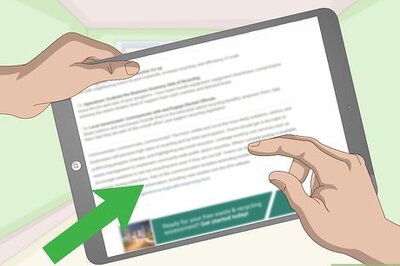
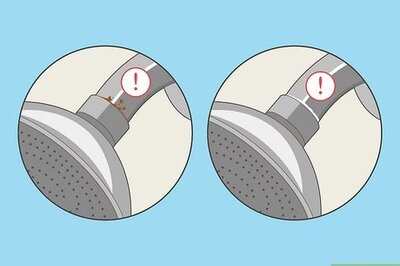
Comments
0 comment